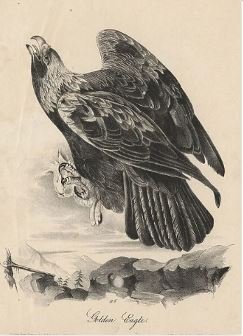The Eagle and the Hare
In History the Eagle is often depicted for its power, a symbol of strength and freedom, as shown here in this striking gilded piece.
The eagle has gracefully swooped down to capture a hapless hare in its talons, its sharp eyes focused. The hare, caught off guard, is frozen in fear as the eagle closes in. The contrast between the eagle's power and the hare's vulnerability is a powerful reminder of the natural world's delicate balance.
This notion of a greater power over something lesser has been portrayed throughout history in the format of the eagle and the hare.
Below you will see examples from fables, artworks and ancient myths that all depict the importance of what this statuesque piece represents.
Francis Barlow (1626-1704) and Jan Griffer I (c.1652-1718) (attributed to) and John Smith (1652-1743)
The Courtauld, London (Samuel Courtauld Trust)
JRB Collection
1811 (etching) by Howitt, Samuel (1756-1822); (add.info.: An eagle swoops down to grab a hare with its beak and talons. Meanwhile a hawk hovers over a gloating sparrow. Eagle, hare, hawk and sparrow. Illustration of a fable by Greek author Aesop. Copperplate etching drawn and engraved from life by Samuel Howitt from his own A New Work of Animals, Principally Designed from the Fables of Aesop, Gay and Phaedrus, Edward Orme, London, 1811.)
'The Eagle and The Sparrow' – Aesop Fable
A Hare being seized by an Eagle, cried out in a piteous manner. A Sparrow sitting on a tree close by, so far from pitying the poor animal, made merry at his expense. “Why did you stay there to be taken?” said he. “Could not so swift a creature as you are have easily escaped from an Eagle?” Just then a Hawk swooped down and carried off the Sparrow, who, when he felt the Hawk’s talons in his sides, cried still more loudly than the Hare. The Hare, in the agonies of death, received comfort from the fact that the fate of the mocking Sparrow was no better than his own.
Wenceslas Hollar - The eagle and the beetle
Thomas Fisher rare book library
'The Eagle and the Beetle' – Aesop fable
An Eagle was chasing a hare, which was running for dear life and was at her wits' end to know where to turn for help. Presently she espied a Beetle, and begged it to aid her. So when the Eagle came up the Beetle warned her not to touch the hare, which was under its protection. But the Eagle never noticed the Beetle because it was so small, seized the hare and ate her up. The Beetle never forgot this, and used to keep an eye on the Eagle's nest, and whenever the Eagle laid an egg it climbed up and rolled it out of the nest and broke it. At last the Eagle got so worried over the loss of her eggs that she went up to Jupiter, who is the special protector of Eagles, and begged him to give her a safe place to nest in: so he let her lay her eggs in his lap. But the Beetle noticed this and made a ball of dirt the size of an Eagle's egg, and flew up and deposited it in Jupiter's lap. When Jupiter saw the dirt, he stood up to shake it out of his robe, and, forgetting about the eggs, he shook them out too, and they were broken just as before. Ever since then, they say, Eagles never lay their eggs at the season when Beetles are about.
Throughout history, looking back at works of art dating to the 18th Century and beyond. The subject matter of The Eagle and the Hare has been depicted in varying mediums. However, what all these pieces seem to have in common is the the overall feeling or notion of dominance. The affirmation of power over another but represented in the most natural form of nature’s life cycle of predator and prey. The imagery seems to evoke an acceptance that it is a natural process but however conjures a deeper manifestation of strength, power and oppression over another.
Jean-Baptiste Berré - Eagle catching a hare; 1811
Eagle Catching Hare 1779;Johann Friedrich von Grooth
Golden Eagle and Mountain Hare;Thorburn, Archibald (1860-1935)
Eagle and rabbit;Leon Bonnat 1897
Golden Eagle, litho by J.T. Bowen, from Birds of America, 1840
Eagle catching a rabbit on an Etruscan vase, from Caere (ca. 550-530 BCE)
The Libation Bearers: Agamemnon and Menaleus
On their way to Troy, Agamemnon and Menaleus see an omen that bodes ill. Two eagles swoop down upon a pregnant hare and tear her to shreds. The eagles represent the warrior kings, and the hare represents Troy. While they will be victorious, they will do so by committing bloody acts that are sure to bring retribution.
Even dating back to the time BCE, the notion is that the Eagle represents honesty, truth, majesty, strength, courage, wisdom, power and freedom. As they roam the sky, they are believed to have a special connection to God.
The large stature of this piece alongside the incredible attention to detail, wonderfully executed by our restoration workshop team at Butler and Castell really makes it something special to withhold.
A showstopping piece that both highlights incredible craftmanship alongside a rich history of the tales of the Eagle and the Hare.













